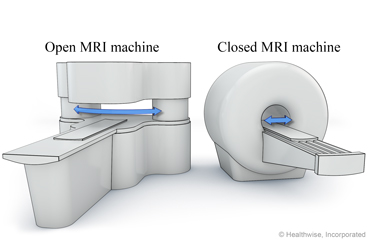
What is it?
MRI (magnetic resonance imaging) is a test that uses a magnetic field and pulses of radio wave energy to make pictures of the organs and structures inside the body. An MRI of the heart looks at the structures and blood vessels of the heart.
When you have an MRI, you lie on a table and the table moves into the MRI machine. A special dye (contrast material) may be put in a vein (I.V.) in your arm or hand to make the blood vessels easier to see on the scan.
Why is this test done?
An MRI of the heart is done to look at the structures and blood vessels of the heart. These may include:
- The heart muscle and the sac around the heart (pericardium).
- The heart valves.
- The coronary arteries. These are the blood vessels that bring blood to your heart muscle.
- The blood vessels that carry blood from the lungs to the heart.
- The aorta. This is a large blood vessel that carries blood from the heart to the rest of the body.
How do you prepare for the test?
In general, there's nothing you have to do before this test, unless your doctor tells you to.
Tell your doctor if you get nervous in tight spaces. You may get a medicine to help you relax. If you think you'll get this medicine, be sure you have someone to take you home.
How is the test done?
Before the test
- You may have contrast material (dye) put into your arm or hand through a tube called an I.V.
- You will remove all metal objects. These include hearing aids, dentures, jewelry, watches, and hairpins.
- You will take off all or most of your clothes and then change into a gown. If you do leave some clothes on, make sure you take everything out of your pockets.
- If you wear a medicine patch, you may need to remove it. The MRI can cause burns with some patches.
During the test
- You will lie on a table that is part of the MRI scanner.
- Small pads or patches (electrodes) will be placed on your skin on each arm and leg and on your chest. The electrodes are hooked to a machine that traces your heart activity onto a paper.
- The table will slide into the space that contains the magnet.
- Inside the scanner you will hear a fan and feel air moving. You may hear tapping, thumping, or snapping noises. You may be given earplugs or headphones to reduce the noise.
- You will be asked to hold still during the scan. You may be asked to hold your breath for short periods.
- You may be alone in the scanning room. But a technologist will watch through a window and talk with you during the test.
How does having an MRI of the heart feel?
- You won't have pain from the magnetic field or radio waves used for the MRI test. You may be tired or sore from lying in one position for a long time.
- If a contrast material is used, you may feel some coolness when it is put into your I.V.
- In rare cases, you may feel:
- Tingling in the mouth if you have metal dental fillings.
- Warmth in the area being checked. This is normal. Tell the technologist if you have nausea, vomiting, a headache, dizziness, pain, burning, or breathing problems.
How long does the test take?
The test usually takes 30 to 60 minutes but can take as long as 2 hours.
What are the risks of an MRI of the heart?
Risks from contrast material
- Contrast material that contains gadolinium may be used in this test. But for most people, the benefit of its use in this test outweighs the risk. Be sure to tell your doctor if you have kidney problems or are pregnant.
- There is a slight chance of an allergic reaction if contrast material is used during the test. But most reactions are mild and can be treated using medicine.
- If you breastfeed and are concerned about whether the contrast material used in this test is safe, talk to your doctor. Most experts believe that very little dye passes into breast milk and even less is passed on to the baby. But if you are concerned, you can stop breastfeeding for up to 24 hours after the test. During this time, you can give your baby breast milk that you stored before the test. Don't use the breast milk you pump in the 24 hours after the test. Throw it out.
What happens after the test?
- You will probably be able to go home right away. It depends on the reason for the test.
- You can go back to your usual activities right away.
- If you had dye, drink plenty of fluids for 24 hours after the test to help flush it out of your body.
Follow-up care is a key part of your treatment and safety. Be sure to make and go to all appointments, and call your doctor if you are having problems. It's also a good idea to keep a list of the medicines you take. Ask your doctor when you can expect to have your test results.
Where can you learn more?
Go to http://www.healthwise.net/patientEd
Enter L518 in the search box to learn more about "MRI of the Heart: About This Test".
Current as of: July 26, 2023
Author: Healthwise Staff
Clinical Review Board
All Healthwise education is reviewed by a team that includes physicians, nurses, advanced practitioners, registered dieticians, and other healthcare professionals.

